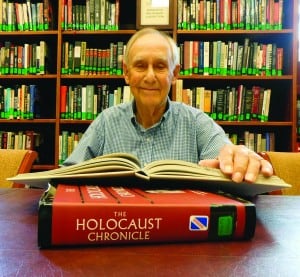The Bonk-Rivin Holocaust Collection at Ohef Sholom Temple is managed by David Titus, a former college professor and academic librarian, and it is here that all corners of the Holocaust are explored. Titus has been a librarian for more than 45 years. He tells Jewish News how he became involved in the collection, how it’s growing, and what you can find there.
Jewish News: When did you first become enamored of books?
David Titus: I discovered books and reading when I was very young. As a child I read anything available—history, Shakespeare, magazines—whatever came to hand. This was reinforced by my English teachers.
JN: Why did you start becoming involved in The Bonk-Rivin Holocaust Collection?
DT: [This] is part of Ohef Sholom Temple’s extensive collection of adult, young adult, and children’s books. My wife Alice and I moved to Norfolk in 2015 and joined Ohef Sholom Temple. As a retired librarian, I was interested in volunteering in the temple library, and I quickly realized the importance of the Bonk-Rivin Holocaust Collection. The Bonk-Rivin Holocaust Library was founded in 1993 at Temple Sinai in Portsmouth by Rick Rivin and the late Ted Bonk. In 2012, when Temple Sinai merged with Ohef Sholom Temple, it became part of the Ohef Sholom Library.
JN: Do you remember your thoughts at the time about this library collection?
DT: It is an impressive and important collection, and having met Rick and Ted, I became interested in moving the collection forward. Teaching the Holocaust to religious school classes has only increased my interest.
JN: What are some of the best-written or most impactful books about the Holocaust?
DT: That’s a tough question. Holocaust books fall into several categories: scholarly histories, survivor memoirs, and works of fiction. To me, the single most important Holocaust book is Elie Wiesel’s Night. Another powerful book is Primo Levi’s Survival in Auschwitz. Books for young readers are particularly difficult to recommend.
The Bonk-Rivin Holocaust Collection contains more than 150 titles for young readers. Everyone is familiar with Anne Frank: The Diary of a Young Girl, but there are many more for young readers. A personal favorite is I Never Saw Another Butterfly—a collection of drawings and poems by children in the Terezín concentration camp. More than 12,000 children under the age of 15 were held in Terezín; more than 90 percent of them did not survive the Holocaust.
JN: Talk about the process of sourcing and acquiring the books.
DT: Over the years, Rick and Ted continued to add books to the collection, and from time to time, other individuals have donated books. Bibliographies from organizations like the Association of Jewish Libraries, the United States Holocaust Museum, and Yad Vashem provide valuable information for ordering new titles from book dealers. From its beginning with 250 titles, the collection now has 1,400 books.
JN: What was the most interesting or rarest book you have or the hardest one to track down?
DT: A few come to mind. One of the most interesting is a German volume from 1934, Männer im Dritten Reich, a collector’s album of brief biographies of 240 Nazi leaders. Published by a German cigarette company, each page has a color portrait “card” pasted in. Our copy is one of the very few complete with all portraits. The collection also includes books signed by authors, and some foreign language titles, including The Holocaust in Farsi, a four-volume set of many primary documents with commentary in Farsi for teaching Iranians about the Holocaust. Also in the collection is Never Again: The Holocaust, a small 28-page booklet of drawings, poems, and essays by students of Booker T. Washington High School in Norfolk. Created in 1989, it reflects students’ reactions to the Holocaust. Ours may be the only publicly available copy.
JN: Does the library have ephemera such as photos, posters, pamphlets, film, etc.?
DT: The collection includes DVDs and VHS tapes. Some relevant photos and other ephemera exist in the temple archives.
JN: Do you find that you continue to learn something new about the Holocaust?
DT: There is always more to learn. Two areas I am currently interested in are America’s actions during the Holocaust and graphic novels of the Holocaust. The collection now has a graphic novel section with more than 20 Holocaust-related titles.
JN: Other comments?
DT: With the Holocaust now more than 75 years in the past, it is critical that we continue to bear witness. As Ted Bonk said when the Holocaust Library was dedicated in 1993 on Yom Hashoah, Holocaust Remembrance Day, “Our young people must be torchbearers of truth. Through Jewish homes, synagogues, and libraries, the truth of the Holocaust survived. The Nazis first burned books, and then people. We will mourn their loss forever.”
When Ted Bonk died in 2020, the Bonk-Rivin Holocaust Library Fund was established in his memory, creating a permanent source of funding for the collection. Donations may be sent to Ohef Sholom Temple, 730 Raleigh Avenue, Norfolk, VA 23507.
The Ohef Sholom Library, which includes the Bonk-Rivin Holocaust Collection, is open to the public. For more information, visit ohefsholom.org.
-Debbie Burke

